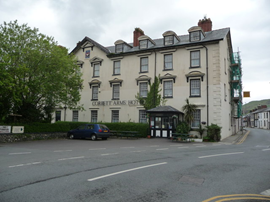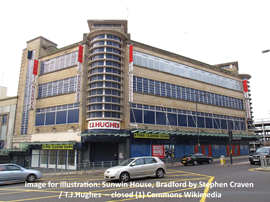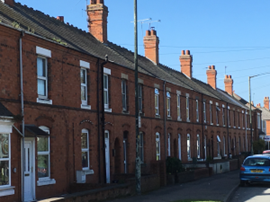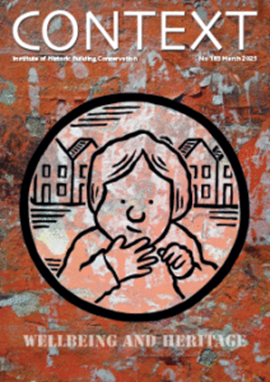Researching and restoring Abbotsford's hothouse
Investigation, conservation and imaginative interpretation are bringing the writer Walter Scott and his garden more vividly to life, while preserving this important garden building.
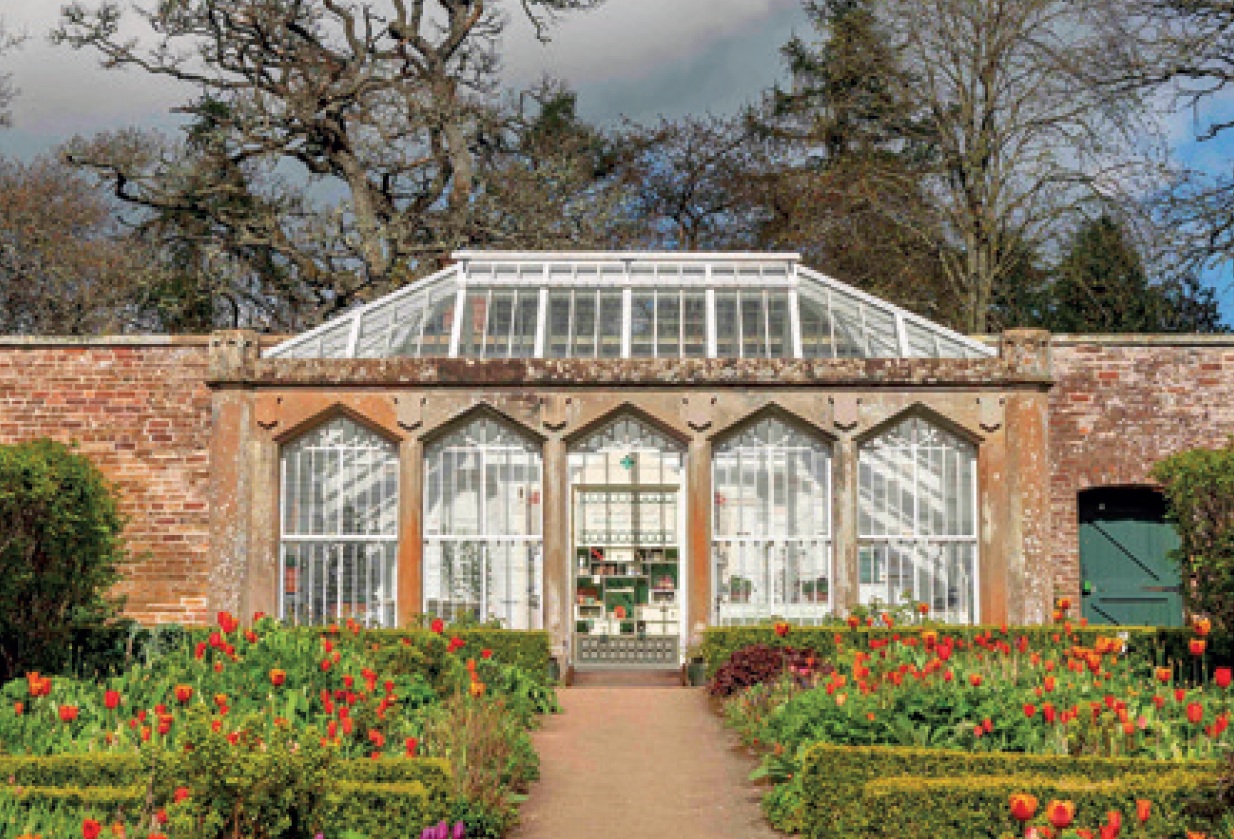
|
| Abbotsford Pavilion: the timber structure sits behind a stone screen. (Photo: The Abbotsford Trust). |
A new visitor experience has been created in a recently restored gothic glasshouse in the walled garden at Abbotsford, the former home of Sir Walter Scott, the Scottish novelist, poet and historian. Abbotsford is Category A-listed and included on the Inventory of Gardens and Designed Landscapes. As part of the conservation project, documentary research and archaeological investigations were carried out to better understand this unusual example of a glasshouse, known as the Pavilion. The building contained hothouse technologies typical of the time and the design was influenced by Scott himself.
Scott’s passionate love of the Scottish borders prompted his purchase of Cartley Hole Farm outside Selkirk in 1811. At this point in his career Scott was clerk of session by day and was already known for his narrative poetry such as The Lay of the Last Minstrel. He had yet to publish the historical novels which, once his initially concealed identity was revealed, elevated him to worldwide fame. Scott created Abbotsford House, a renowned and early example of Scots baronial architecture, between 1816 and 1819. It features crowstepped gables, castellated turrets and bartizans complete with arrow loops. Its pronounced Scottish historical character also incorporated original fragments of historic buildings collected by Scott, including a door from Edinburgh’s Tolbooth (demolished in 1817). When Scott was spectacularly bankrupted in 1826, all but essential building work on the estate came to a halt. The house was opened to the public just five months after his death (he died in 1832) and still contains his collections.
Extending north-east of the house is the walled garden. In their most basic form, walled gardens were designed to protect edible and decorative plants from frost, high winds and animal and human thieves. They could be built with one or more furnaces to warm the walls and provide additional heat for plants and trees trained against them. This allowed plants from warmer climates to grow in the Scottish weather, furnishing the Abbotsford kitchen with soft fruits. The excess heat from the walls also benefited the remainder of the walled garden, creating a warmer, sheltered microclimate for other plants. The garden walls at Abbotsford, constructed with stone on the outside and brick on the inside, contained voids linked with the heating system. The flues surviving within the north-east wall run from the Furnace House, located on the outside of the wall, and provided heat along the length of the wall. The flue’s internal structure, in both the walls and the Pavilion, was constructed to a very high standard and took advantage of the excellent thermal properties of brick.
The Pavilion, against the north-east wall of the garden, was erected in the year before Scott’s bankruptcy. Its curious design is gothic in character, with triangular-headed window openings and octagonal corner piers capped by miniature bartizans. The glazed and hipped roof within a parapet and the masonry arcading are all unusual features. There is evidence that Scott had a hand in refining what seems to have been the mason John Smith of Darnick’s design. Smith had constructed the house and the walled garden for Scott. In an undated letter from Scott to Smith, presumed to be 1824–5, he suggests that the ‘triangular tops’ of the windows as designed by Smith could be changed to make them ‘gothic pointed’. Evidently it was the triangular design which was built.
The design form was speculatively aligned to the form of a medieval siege tent, shown in an illustrated 1805 edition of Froissart’s Chronicles, translated by Thomas Johnes, according to a suggestion made in a 2017 conservation management plan for the designed landscape. Scott commented in the Edinburgh Review in 1805 that the ‘rare and curious illuminations… add greatly to the interest of the publication’, possibly revealing the inspiration for the form of the Pavilion.
The Pavilion was one of the last structures built at Abbotsford in Scott’s lifetime. Despite its masonry arcade, it is a timber-framed building within a stone screen and remarkably retains much of its early 19th-century small-pane glazing. Its central location against the walled garden makes it a designed focal point. Inside the Pavilion there are almost no decorative features aside from a pair of curved niches in the rear wall. The building is connected to a Furnace House to the rear of the wall, outside the walled garden. This has a mono-pitched roof with crowstepped half-gables, continuing the Scottish architectural theme of the estate, even to this modest service building.
Addyman Archaeology undertook historic building recording and an archaeological evaluation of the Pavilion, Furnace House and adjacent garden walls in 2019, with additional work in 2020 and 2022. Five trenches were excavated in the Pavilion, uncovering much of the original heating arrangement.
They revealed that the Pavilion had a horizontal flue running around the interior of the wall below ground level. The flue carried hot air which enabled the cultivation of fruits and tender plants, such as hibiscus, lily of the valley and peaches. Its route extended from an inlet in the east corner of the rear wall – where the flue was connected to a coal-fired furnace in the Furnace House. It went around the perimeter of the Pavilion before exiting into the thickness of the rear wall in the north corner. Although the outlet at this point was obscured, the flue must have risen within the wall to the chimney stack that still exists above. The Pavilion’s glazed timber roof had an upper vent along the ridge and openings that could be adjusted. Along with the windows, these openings allowed for ventilation and moderation of the temperature and airflow.
The Furnace House itself, the engine room of the glasshouse, is built from rubble stone with sandstone dressings and uses recycled roof timbers. The coal chute survives. The archaeological excavations revealed the original cobbled surface of the Furnace House floor and the footings from the original cast-iron furnace; they form a U-shape in the cobbles and helped to determine something of its original form and scale. A representation of the furnace now occupies this original footprint.
At the time of the archaeological investigations, the Pavilion was in a semi-derelict condition, worsened by heavy snowfall which had caused the roofs to collapse in 2010. Simpson and Brown carried out a series of conservation repairs to restore the glasshouse and garden walls, including repairing the timber and glass hipped roof. Historic photographs from the 1920s showed that the roof profile had been changed. When this evidence was considered alongside that of the different moulding profiles of the principal roof timbers, it was clear that it had previously been subject to major reconstruction.
Roof repairs were required as a great deal of rot was encountered. These were restricted as far as possible but significant timber replacement was necessary as part of the works using Douglas fir, identified by TRADA analysis. What little remained of the roof glazing was not original and was replaced. The window openings, however, contained significant amounts of original glass, installed as small overlapping panes in the sash-and-case windows. This unusual vernacular building feature contributes significantly to its character. The small panes are contained in closely spaced vertical astragals with no horizontal members in each sash. Although large areas had been replaced over the years, Addyman Archaeology was able to identify the extent of the surviving early glazing, made recognisable by imperfections in the glass and a slightly green-blue hue in certain overcast lighting conditions. The glazing was removed, cleaned and reinstalled.
Specialist conservators were engaged to stabilise spalling stone on the facade. This did not affect its structural integrity, the Pavilion being a timber structure sitting behind a stone screen. In-house historic paint analysis was carried out to gather evidence of the original paint colour. Suggestions had been made that a heraldic scheme might have been present but this was not found to be the case. Off-white was determined to be on the windows, walls and other detailing. The garden walls, which had structural defects due to insufficient ties, required significant rebuilding, for which mortar analysis informed the repointing specification.
The restored Pavilion now forms part of the wider visitor experience at Abbotsford, along with the subterranean Furnace House, previously closed to the public. The structures reveal Scott’s interest in hothouse technologies and his garden, contributing to the presentation of a more holistic view of his life on the estate. In the Furnace House, visitors can experience an immersive soundscape. A series of spotlights accompanies the audio to illuminate features, helping visitors understand how the Pavilion’s heating system worked.
The Pavilion also contains ‘Sir Walter Scott’s Botanical Cabinet’, which holds an interactive handling collection of objects illustrating how the garden contributed to life at Abbotsford. At the Pavilion’s ‘Listening Bench’, visitors can hear extracts from Scott’s journal, revealing a man who tends to his plants for the benefit of future generations and loses patience with his body as it misbehaves in old age.
This article originally appeared in the Institute of Historic Building Conservation’s (IHBC’s) Context 181, published in December 2024. It was written by Esmé Coppock, heritage consultant for Simpson and Brown with Addyman Archaeology.
--Institute of Historic Building Conservation
Related articles on Designing Buildings Conservation.
- Conservation.
- Conserving and managing historic designed landscapes.
- Conserving structures in historic designed landscapes.
- Energy Efficiency and Comfort of Historic Buildings.
- Energy efficiency of traditional buildings.
- Heritage.
- Historic environment.
- IHBC articles.
- Institute of Historic Building Conservation.
- New HES national centre for traditional building retrofit.
- Retrofit and traditional approaches to comfort.
- Retrofitting traditional buildings.
- Sustainable heating for listed buildings.
- The ability to retrofit is important in all areas of life.
- The secret life of the Georgian garden.
- Walled kitchen gardens of the Isle of Wight.
IHBC NewsBlog
Images from inside a Grade II listed hotel show the scale of its collapse
The Corbett Arms in Tywyn has fallen into serious disrepair.
Old Sarum fire in listed (& disputed) WW1 Hangar - Wiltshire Council has sought legal advice after fire engulfed a listed First World War hangar that was embroiled in a lengthy planning dispute.
UK Antarctic Heritage Trust launches ‘Virtual Visit’ website area
The Trust calls on people to 'Immerse yourself in our heritage – Making Antarctica Accessible'
Southend Council pledge to force Kursaal owners to maintain building
The Council has pledged to use ‘every tool in the toolbox’ if urgent repairs are not carried out.
HE’s Research Magazine publishes a major study of the heritage of England’s suburbs
The article traces the long evolution of an internal programme to research 200 years of suburban growth
IHBC Context 183 Wellbeing and Heritage published
The issue explores issues at the intersection of heritage and wellbeing.
SAVE celebrates 50 years of campaigning 1975-2025
SAVE Britain’s Heritage has announced events across the country to celebrate bringing new life to remarkable buildings.
IHBC Annual School 2025 - Shrewsbury 12-14 June
Themed Heritage in Context – Value: Plan: Change, join in-person or online.
200th Anniversary Celebration of the Modern Railway Planned
The Stockton & Darlington Railway opened on September 27, 1825.
Competence Framework Launched for Sustainability in the Built Environment
The Construction Industry Council (CIC) and the Edge have jointly published the framework.






